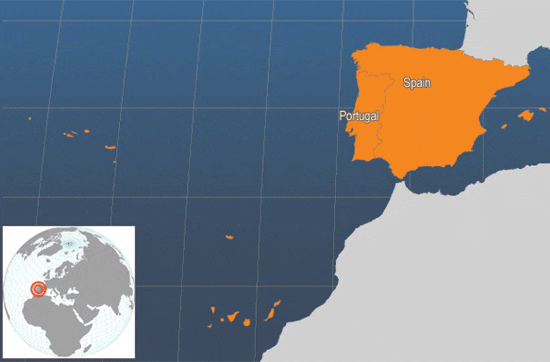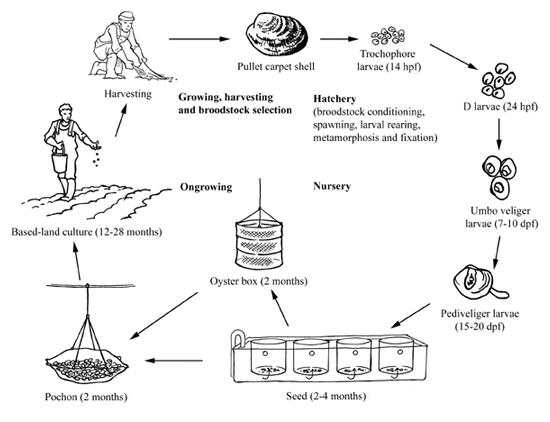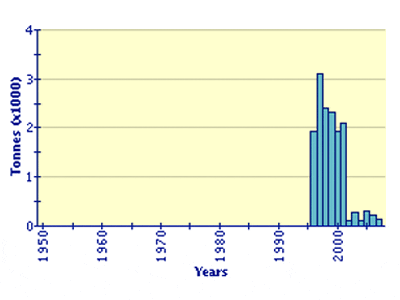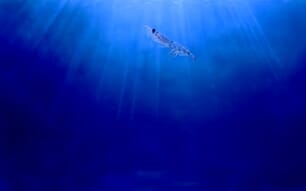Identity
Venerupis pullastra (Montague, 1803 )
FAO Names: En - Pullet carpet shell, Fr - Palourde bleue, Es - Almeja babosa
Biological Features

Shell solid, equivalve; inequilateral, beaks in the anterior half; somewhat broadly oval in outline. Ligament inset, not concealed, a thick brown elliptical arched body extending almost half-way back to the posterior margin. Lunule elongate heart-shaped, clear though not particularly well defined, with light and dark brown fine radiating ridges. Escutcheon reduced to a mere border of the posterior region of the ligament. On the surface light lines parallel to the border of the shell. Growth stages clear. Pallial sinus relatively deep though not extending beyond the centre of the shell; it leaves a wedge-shaped space between its lower limb and the pallial line. Margin smooth. Grey to cream with bands of darker colour. Siphons attached along the whole length; this feature distinguishes this species from Ruditapes decussatus.
Profile
Historical Background
The harvesting of Venerupis pullastra mainly occurs in Spain, Italy, Portugal and France. In Spain, early records of mollusc fishing and consumption from the 16th century are mainly about the flat oyster, and only rarely about clams, but they do mention the marketing of clams in Portugal and other places. Intensive fishing for clams began in 1926 and 1927. Digging was indiscriminate, as fishermen used prohibited tools and took clams of all sizes.
Despite the large clam harvests, their repopulation is rapid. In 1948 it was estimated that populations of Ruditapes decussatus and Venerupis pullastra in the Ria del Burgo (Spain) recovered in less than a year from a density of 1-5 to 30-50 clams/m2. In 1956, clam production in the Galician region of Spain was about 60 percent of national production. At that time, 250 boats fished for bivalves near San Simon in the ria de Vigo; each harvested from 10-12 kg of V. pullastra per day (2 500 kg in total). The season was from October to March, while in areas nearest to the mouth of the bay about 60 boats worked and obtained 3 000 kg/day. These differences were associated with the great mortality that occurred in the inner part of the ria de Vigo, due to heavy rains that produced a rapid drop in salinity. In the ensuing years, clam production has been variable, and statistical data on total production is sparse. However, the steady fishing of the natural populations led to a reduction in natural populations, a diversification of the species collected to include V. rhomboideus, and a search for new collecting areas. From 1985 to 1986, production of the clams V. pullastra and V. rhomboideus, from capture and culture, was around 1 700 tonnes.
Main Producer Countries
Venerupis pullastra is mainly harvested in Spain, Portugal, France and Italy. In Spain and Portugal the clam fishery targets three main species: Ruditapes decussatus, locally known as 'almeja fina'; Venerupis pullastra, called 'almeja babosa'; and V. rhomboideus, called 'almeja rubia'. Total production from harvests of the natural beds in the Galician bays was estimated at 2 000 tonnes in 1990. Other production areas are Cadiz and Huelva in the south of Spain.

Habitat and biology
The pullet carpet shell lives burrowed in sand and silty mud. It is a lamellibranch bivalve mollusc that filters water through its 2 siphons (one in and the other out) catching organic matter (detritus) and phytoplankton as food. The gills are two pairs of plates composed of filaments. Clams live on the sandy beaches of the rias (flooded river valleys). Venerupis pullastra is buried in sand, gravel or mud bottoms, usually from the low tide mark to a depth of 40 m. Its sexes are separate, although hermaphrodites can be found infrequently. Reproduction is external and takes places mainly during summer in the wild, and/or on hatcheries. In spring, clams can be artificially conditioned for hatching with higher temperature water and abundant food. The larvae swim freely for 10-15 days before settling as spat of about 0.5 mm on a sand and silty mud substrate.
Production
Production Cycle

Production Systems
Seed Supply
Farmers obtain seed from their own parks (protected bottoms) or from the natural clam populations in the spring. They dig the clam seed with sand using a small shovel, pass it through a sieve to retain the seed, take it to their ongrowing parks, and spread it in densities of about 800 clams/m2. They may also dig adult clams from seaport areas and spread them in their parks. Periodically, they have to clean their parks of predators and mud.
Hatchery Production
Seed can also be obtained from hatcheries, where breeders, not exceeding 40 mm are maintained for 30-40 days at 20 °C. Breeders are fed with unicellular algae until the induction of the liberation of gametes. Gamete liberation can be induced by raising the temperature from 10 to 26 °C, maintaining it at that temperature for 30 minutes and then reducing it to 15 °C for several minutes; the cycle of raising temperature to 26 °C and lowering it again is then repeated until gametes are liberated. The addition of sperm from a sacrificed animal may also help in liberation. Fertilization occurs in small containers where the animals are isolated from each other. Eggs are filtered through a 40 µm mesh, and transferred to a 10 litre tank, where veliger larvae appear after 48 hours. Larvae are recollected in a 40 µm mesh and reared at densities of 3 000 larvae/litre. They are fed with unicellular algae every day during the first week and then every second day until metamorphosis.
Nursery
Clams can be reared in nurseries within greenhouses, with controlled feeding by using unicellular algae, or reared in meshed containers over culture tables. An alternative is to pump environmentally controlled water to inland tanks where clams are placed in cylindrical containers of about 50 cm diameter and 20 cm long, with a bottom made of a rigid mesh.
Ongrowing Techniques
Culture techniques are simple, consisting of seeding juvenile clams; regular maintenance of the substrate; avoiding seaweed and predators such as crabs and starfish; oxygenating the substrate with shovels and rakes and discarding seaweed growth; and maintaining an appropriate clam density. Ongrowing requires the clams to be submerged; burrowing reduces the level of shell malformations. Most clams become submerged in the substrate within an hour after sowing. Clams can either be placed in beds without any control other than periodic cleaning or in structures such as nets that may minimize predator impact but increase maintenance costs. In summary, the culture technique is simple.
Harvesting Techniques
In the Galician region (Spain), fishermen harvest clams by walking the intertidal areas and using special hand shovels, or sometimes by using the rakes that are normally used for keeping the culture beds clear of seaweed. Clams may also be harvested from boats, which may vary in size between less than 1 tonne and up to 12 tonnes. Some are propelled with oars, others with outboard engines. Various collection tools are used, including the 'rastro' and the 'raño' (rake), which are operated from the boats with the help of a long handle. The closed season is from March to October, and the minimum size allowed for Venerupis pullastra is 25 mm. Some Galician areas have protected bottoms called 'parks' for the extensive culture of clams. In hand (walking) harvesting clams are harvested with the help of different types of small shovels; sometimes the rakes that are usually more employed for cleaning the parks of seaweeds are employed.
Handling and Processing
Fishermen bring their clams to depuration stations where they are held in tanks for at least 42 hours. The clams are then packed in net bags of 0.5 - 1 and 2 kg, and are destined to be canned or eaten fresh. They are transported by refrigerated trucks which maintain their temperature at 3-10 °C; the clams have a shelf life of 5 days.
Production Costs
Production costs are greatly influenced by the socio-economic environment and the size of seed supplied. If nursery time starts in spring, harvesting occurs in the late fall or early winter of the following year. Important factors in total costs are seabed leases or exploitation charges hatchery and nursery facility costs, management and harvesting tools and labour.
Diseases and Control Measures
| Disease | Agent | Type | Syndrome | Measures |
|---|---|---|---|---|
| Perkinsosis; Clam Perkinsus disease | Perkinsus olseni; P. atlanticus | Protistan parasite | Visible milky white cysts or nodules on the gills, foot, gut, digestive gland, kidney, gonad & mantle of heavily infected clams; may induce massive mortality | Clams from areas with records of the disease should not be transplanted; reduce density |
| Icosahedrical virus-like disease of carpet shell clams | Icosahedrical virus-like organism | Virus | Impact on host not specifically described but mortality can be significant | None known |
| Brown ring disease | Vibrio tapetis | Bacterium | Bacteria adhere to surface of periostracal lamina at mantle edge of shell & progressively colonize the resulting secretion causing brown deposit of organic material (conchiolin) adhering to inner surface of shell; normal calcification process disturbed; growth stunted | Clams from areas with records of the disease should not be transplanted; reduce density |
| Ciliate infestation | Trichodina sp. | Trichodinid ciliate | Most infections are innocuous; intensity of infection usually low with ciliates attached to, or located near mantle, along siphons, or gill surface | No known methods of prevention or control |
| Turbellarian infestation | Paravortex sp. | Flatworm parasite | No known affect on host; thought to pass freely between mantle cavity and alimentary canal; often observed on gill surface; rarely observed in lumen of kidney; probably midway between being endocommensal and parasitic | Prevention and control impractical |
| Nocardia | Nocardia kampachi | Bacterium | Swollen lesions and ulcers on body surface; nodules sometimes present on gillsl | Control restricted to avoiding introduction of infected fish or fish products |
| Trematode infestations | Unidentified cercarias and metacercarias | Trematodes | Generally innocuous | Prevention and control impractical |
Among bivalve competitor species growing with Venerupis pullastra are Venerupis rhomboideus, Venerupis aurea, Ruditapes decussatus, Dosinia exoleta and Tellina incarnata. Their main predators are the shore crab (Carcinus maenas); starfishes (Asteria rubens and Marthasterias glaciais); gastropods (Natica sp.); and birds (Larus sp). An individual shore crab (6.5 cm width) can consume 5-6 clams per day. Nets are used in some culture areas to control predators.
Suppliers of pathology expertise
Expertise in pathology can be obtained from:
Dr. Antonio Figueras
Instituto Investigaciones Marinas, CSIC
Spanish National Reference Laboratory for Mollusc Diseases
Eduardo Cabello 6
36208 VIGO
Spain
Telephone: +34 986 21 44 62
Fax: +34 986 292 762
Dr. Isabelle Arzul
IFREMER, Laboratoire de Génétique et Pathologie
BP 133
17390 La Tremblade
France
Telephone: +33 5 46 36 98 43
Fax: +33 5 46 36 37 51
Dr. E.M. Burreson
Director for Research and Advisory Services
Virginia Institute of Marine Science
College of William and Mary
P.O. Box 1346 Gloucester Point
VA 23062
United States of America
Telephone: +1 804 684 7015
Fax: +1 804 684 7097
Dr. S. Bower
Department of Fisheries and Oceans Pacific Biological Station
3190 Hammond Bay Road
Nanaimo
British Columbia V9R 5K6
Canada
Telephone: +1 250 756 7077
Fax: +1 250 756 7053
Dr. Jorge Cáceras Martínez
Instituto de Sanidad Acuícola, A.C.
Calle 9 y Gastelum # 468,13,14. CP. 22800
Ensenada Baja California
Mexico
Telephone: +52 646 1783473
Fax: +52 646 1783473
Statistics
Production Statistics

(FAO Fishery Statistic)
Production levels in Spain varied from 1 900-3 100 tonnes/yr from 1996 until 2002, when they fell markedly to only 50 tonnes. By 2004, production had recovered slightly to 300 tonnes, possibly due to disease problems, especially brown ring disease, and poor management. Very limited production has also been reported from Portugal, but has never exceeded 2 tonnes/yr.
Market and Trade
All the clams (Ruditapes decussatus, locally known as 'almeja fina'; Venerupis pullastra, called 'almeja babosa'; and Venerupis rhomboideus, called 'almeja rubia') harvested in the Galician region are valuable, and V. pullastra is considered as a traditional food. The quality of V. pullastra is similar to the other clam species but its shelf life is notoriously inferior. This is due to its deeper situation and lack of exposure at low tide. For this reason, lack of durability, its market price is generally lower than the other species. Prices vary according to their abundance in the market. In 2005, the price for live V. pullastrain Spain was about EUR 10/kg.
Status and Trends
The history of shell fisheries in the Galician region (Spain) shows that molluscs were managed improperly, and various species have been impacted. The first to be depleted was flat oyster (Ostrea edulis); after that the digging of cockles and clams began, and as Ruditapes decussatus became scarcer, the digging of Venerupis pullastra began. Currently, the populations of the other commercial bivalves are declining. Besides heavy fishing, clams have declined because pollution increased and the seaports and urban areas grew, degrading their habitat.
Main Issues
The future of the molluscan production in the Galician Region needs to be planned as an integral reorganization programme to include the following aspects:
- Reorganization of the harvesters and the market structure to improve their responsibility and enhance their profits.
- Creation of protected areas for the recovery and growth of the natural populations.
- Creation of a general programme for the treatment of wastewater from the urban and industrial areas.
- Establishment of a permanent project on the population dynamics of the clams, and biological studies, especially to improve genetics.
- Diffusion of a popular programme for the protection and consumption of bivalve molluscs.
- Creation of a special research programme on molluscan pathology.
Responsible Aquaculture Practices
No negative effects on other species have been established but responsible aquaculture practices need to be followed (see Main Issues above).
November 2010




